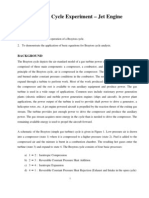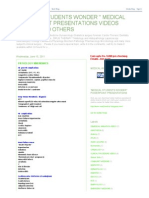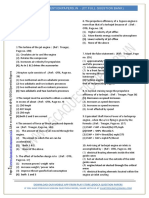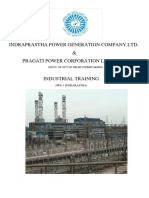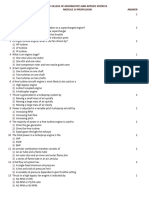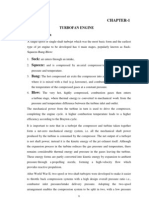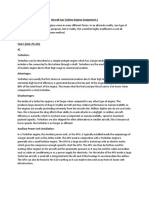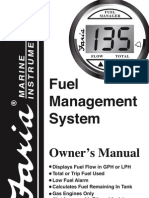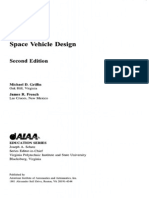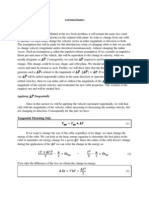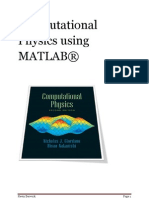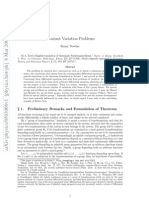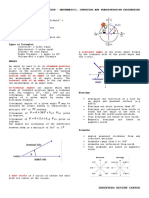Understanding The 914 Rotax
Understanding The 914 Rotax
Uploaded by
pride3351Copyright:
Available Formats
Understanding The 914 Rotax
Understanding The 914 Rotax
Uploaded by
pride3351Original Description:
Original Title
Copyright
Available Formats
Share this document
Did you find this document useful?
Is this content inappropriate?
Copyright:
Available Formats
Understanding The 914 Rotax
Understanding The 914 Rotax
Uploaded by
pride3351Copyright:
Available Formats
UNDERSTANDING THE 914 ROTAX
Warning: All information is provided for training purposes only. Always refer to the appropriate manual provided by BRP-ROTAX.
This following is a brief summary of the 914 turbo system. This summary is provided to assist owners and operators better understand the engine and reach optimum operational conditions. Reading these instructions will not eliminate a hazard, but understanding and applying the information will enhance the operation of the engine. 1) TURBO CONTROL UNIT (TCU)............................................................................. 2 2) TWO AIR-PRESSURE SENSORS............................................................................ 3 3) TACHOMETER READ OUT .................................................................................... 3 4) AIRBOX TEMPERATURE SENSOR....................................................................... 3 5) SERVO MOTOR ........................................................................................................ 4 7) THROTTLE POSITION SENSOR CALIBRATION ................................................ 5 8) THROTTLE POSITION DETENT OR MARK......................................................... 5 9) ENRICHENER SOLENOID ...................................................................................... 6 10) AIR BOX TEMPERATURE .................................................................................. 6 11) RPM, CHT, OIL TEMP, OIL PRESSURE, ETC,.................................................. 7 12) SUITABLE FUELS ................................................................................................ 7 13) FUEL PUMPS ........................................................................................................ 8 14) FUEL REGULATOR ............................................................................................. 9 15) FUEL PRESSURE................................................................................................ 10 FUEL RETURN LINE ......................................................................................... 11 16) 17) SUITABLE PROPELLER.................................................................................... 11 CARBURETOR HEAT ........................................................................................ 11 18) 19) ELECTRICAL POWER SUPPLY ....................................................................... 12 20) ALTERNATOR AND FUEL PUMP CONTROL ............................................... 12 21) SUMMARY OF ELECTRICAL SYSTEMS ....................................................... 13 SUMMARY OF THINGS TO REMEMBER ...................................................... 14 22) CONVERSION TABLE................................................................................................... 15
-2-
1) TURBO CONTROL UNIT (TCU)
The TCU is the brain of the system designed to sense and deciphers data from the engine and determines the wastegate setting to achieve the optimum level of boost. The operating program within the TCU controls these functions. To monitor what is taking place within the TCU, a communication program (TLR) is available to monitor the TCU and determine which sensor pickups are being received. The TLR program also enables users to view and record engine parameters for review and evaluation. Two operating lights are required for the TCU, which are to be installed in the aircraft panel. As the master switch is turned on both lights are momentarily activated to indicating power is supplied to the TCU and that normal electrical power-up has occurred.
1. The Caution light (green on early version 914, orange light on later
versions). A blinking warning light indicates a sensor or wiring failure.
2. The Warning light (red light) is attached to a built-in timer which is
activated whenever the throttle is placed in the full throttle position. This light comes on after 5 minutes of full throttle operation and resets itself each time the throttle power setting is below the 108% position for a minimum of 5 minutes. The purpose of this is to prevent the operator from using full throttle for more than 5 minutes, which could result in excess heat build-up in the engine. The red light will permanently illuminate if an overboost situation occurs. Return to index
-3-
2) TWO AIR-PRESSURE SENSORS
The ROTAX 914 engine is equipped with two air-pressure sensors. One measures aircraft ambient pressure and the other measures airbox pressure. Both air-pressure sensors report to the TCU and play a vital function in helping the TCU achieve the optimum level of boost. It is critical that the ambient pressure sensor is sensing from a neutral pressure zone within the aircraft. Generally the aircraft static source is a good place for this sensor. (consult airframe manufacture)
3) TACHOMETER READ OUT
An internal tachometer is built into the TCU which receives vital sensory inputs from a designated trigger coil on the engine. This same trigger coil can also drive a second electric tachometer on the instrument panel. An optional mechanical tachometer drive is also available
4) AIRBOX TEMPERATURE SENSOR
This sensor monitors the airbox temperatures. The TCU operating program is designed to reduce boost pressure if this sensor indicates the airbox temperature is above 88C (190F) (72C for older model TCU). In the normal course of running a turbo, the natural compression of air (adiabatic compression) as well as heat transfer from the hot turbo, raises the temperature of the incoming intake air. Testing has shown that intake air temperatures below 60C (140F) provides an adequate safety margin in preventing detonation in the engine in the event of a lower octane fuel and a high intake air temperature. In cases where the airbox temperature is run between 60C (140F) and 72C (162F), a higher-octane fuel must be used (see suitable fuels: section 12 of this article and section 10.2.2 of your Operators Manual). On certain installations and geographic areas, high airbox temperatures may be a problem, resulting in less than optimum performance. An intercooler may be required to keep the intake air box temperature down to a reasonable level. Your testing should verify this potential problem with your particular installation without an intercooler. The operator may have to reduce power if the airbox temperature gets too high, otherwise the TCU will do it automatically by opening the wastegate. Some operators have elected to install an additional airbox temperature gauge in the aircraft panel, so the pilot can tell exactly how high the airbox temperature is getting. Special consideration must be given to carb icing, especially when using an intercooler. See section 17 of this article for more information on carb heat. Return to index
-4-
5) SERVO MOTOR
The servo motor is controlled by the TCU and adjusts the wastegate position. On initial start-up, the servo motor will cycle for a new position as the TCU is establishing the sensory inputs. Normally the servo motor will turn to of a turn in one direction, and then return to its original pre-start-up position. After this cycle, the wastegate should be fully closed. The servo cable is adjusted at the factory, but must be re-adjusted if the cable is disconnected. It may also require some fine tuning once the cable stretches. It is important to note that after initial start-up and the servo cycles, the cable is adjusted to shut/close the wastegate. Over-tightening the cable will put undue load on the servo, too loose a cable will not fully close the wastegate and could cause the cable to tangle. Refer to current maintenance Manual for wastegate adjustment.
6) THROTTLE POSITION SENSOR
This sensor is mounted on the 2/4 carb and relays to the TCU the exact position of the throttle. When correctly calibrated it relays 0% position at idle to 115% at wide open position. The TCU operating program is designed to start adding full boost when the sensor relays a 108% to 115% throttle position. It is important to note that the maximum continuous cruise throttle position is 100% (35 inHg at 5500 RPM). It is not advisable to cruise in the 108% area. In this position the TCU will add full boost as its logic thinks you are going to full power. From 108% to 110% throttle position it is very difficult to set your manifold pressure to a given value, as the throttle becomes very sensitive in this area. For this reason it is recommended to make a detent or mark on your throttle so the pilot can recognize exactly where 100% is, allowing the pilot to avoid the sensitive 108% throttle position. Correct calibration of the throttle position sensor is critical, and is an adjustment you can achieve, using the TLR communication program. It is possible to manually mark throttle positions, based on the calibration sheet (supplied by the factory) which details the exact throttle positions through a physical measurement taken on the carburetor throttle arm above the number four cylinder. Using this data, the engine installer can mark the exact throttle position in the cabin, so the pilot can easily identify specific throttle settings. This will assist in proper operation of the engine during flight and help verify proper TCU function and throttle position calibration. Please review the above section until it is clearly understood.
-5-
7) THROTTLE POSITION SENSOR CALIBRATION
Under the guidance of a trained 914 mechanic/specialist and using a PC and a special communication program (TLR) you can ensure that the TCU operating program reads 0% position when the throttle is at idle, and 115% position at full throttle. Detailed instructions can be found in the current maintenance manual and the TCU Users Guide In the event that the pilot cannot match the power settings as shown on the chart in section 10 of the Owners Manual, a recalibration of the throttle position sensor may be required. Contact your local service centre for assistance in this regard.
8) THROTTLE POSITION DETENT OR MARK
As previously discussed, using the physical or visual means of verifying the 100% throttle position, which should equate to 35 airbox pressure and 5500 RPM, helps verify that the system is calibrated correctly. The normal procedure to set maximum cruise is to bring the throttle back to 100% throttle position mark, then adjust the RPM via the prop pitch (with adjustable props) to 5500 RPM, and finally verify that the airbox pressure is 35inHg (1inHg) If you want to increase power, you would first adjust to the desired RPM, using the prop pitch, then increase the throttle to the corresponding throttle position, and finally verify that the airbox pressure is correct. The following is the correct airbox pressure for a given RPM, for all full and cruise power settings.
RPM 5800 5500 5000 4800 MAP inHg 40 35 33 31 Percent of power 100% Power (Full Throttle) 85% Power (Maximum Cruise) 75% Power (Normal Cruise) 65% Power (Economy Cruise) Throttle position 115% Throttle Position 100% Throttle Position Approx. 85% Throttle Position. Approx. 65% Throttle Position
It is important to note that 115% throttle position equates to 100% engine power (full take-off power), dont get the two number confused. Return to index
-6-
9) ENRICHENER SOLENOID
The enrichener solenoid (or valve) is mounted on later production series engines to better control carburetor mixture. In order to maintain proper air pressure the carburetor float bowls are vented to the airbox. By increasing the air pressure in the float bowls the engine can be made to run richer, thereby cooling the combustion chamber and preventing detonation. The standard routing of the float bowl vent is to inside the airbox. When the Enrichener Solenoid is activated the float bowl vents are routed to a ram air port near the turbo inlet tube. This solenoid valve is activated by the TCU sensing throttle positions above 108%, which creates a richer fuel mixture to help prevent detonation during high engine loads.
10)
AIR BOX TEMPERATURE
Make sure you pay attention to how your particular installation affects the airbox temperature. Remember once the airbox temperature rises to 88C (190F) (72C for older model TCU), the TCU will automatically decrease boost pressure by opening the wastegate. This could happen before the 5 minute time limit is up. In most cases full boost is only required for short periods during takeoff, and the pilot knowing his airbox temperature is nearing 88C (190F), can adjust accordingly. Return to index
-7-
11)
RPM, CHT, OIL TEMP, OIL PRESSURE, ETC,
Maximum RPM Maximum continuous RPM Maximum Cylinder Head Temp. Minimum Oil Temperature Maximum Oil Temperature Normal Oil Operating Temp. Normal Oil Pressure Maximum Oil Pressure Minimum Oil Pressure below 3500 rpm Minimum Oil Pressure above 3500 rpm Maximum Exhaust Gas Temperature Normal Exhaust Gas Temperature 5800 for 5 minutes 5500 135C / 275F 50C / 120F 130C / 265F 90 to 110C / 190 230F 1.5 5 BAR / 22 73 PSI 7 BAR / 102 PSI 0.8 BAR / 12 PSI 1.5 BAR / 22 PSI 950C / 1742F 900C / 1652F
Respect all operational limits:
12)
SUITABLE FUELS
Fuels are commonly rated based on octane quality or Anti-Knock Index (AKI). The AKI is a measure of fuels ability to resist engine knock (ping). The AKI of a motor fuel is the average of the Research Octane Number (RON) and the Motor Octane Number (MON), or {(RON +MON) / 2}. The AKI is often displayed on the gasoline pump. Optimum performance and fuel economy is achieved when the AKI of a fuel is adequate for the engine in which it is used. The RON and MON of fuels are measured by recognized laboratory engine test methods. Results of these tests may generally be translated into approximate field performance. In general, the RON affects low to medium speed knock and engine run-on. If the RON is too low, the engine could experience engine knock during periods of power acceleration such as during a takeoff or climb. The anti-knock performance of a fuel, in the case of a 914, is established by ROTAX using the RON. When the airbox temperature is below 60C (140F), under all flight conditions, an unleaded minimum 91 octane rated fuel can be used. Above 60C (140F) airbox temperature, a premium unleaded minimum 92 octane rate fuel (RON 98) must be used. If it is difficult to establish a certain fuels octane level, always choose the higher number, with 100LL also being a viable choice. When choosing 100LL fuel, operators must consider the longterm disadvantages of this high lead content fuel, such as greater deposits in the combustion chamber, piston rings and higher valve seat wear. Return to index
-8-
13)
FUEL PUMPS
The electrical pumps are an auto-suction vane-cell type. The electrical fuel pumps should be installed near the fuel tank in order to guarantee a safe fuel supply through the advantage of a cool mounting place, particularly during hot operation. The fuel pumps should be mounted below the level of the fuel or under the tank (maximum suction height of 250mm or 10). When mounting the electrical fuel pumps, vapour lock situations must be taken into consideration (see installation manual). It is not recommended to mount the pumps in the engine compartment unless they are properly heat and fire shielded. For redundancy, one electric fuel pump acts as the main pump, and is usually powered by the internial18 amp generator. For simplicity it is wired with no switch other than a pull type circuit breaker for wire protection and pilot control. The other pump acts as the auxiliary, and is generally wired off the bus bar. This pump should be switched so the pilot can manually control it. NOTE: Check valves are needed to prevent reverse flow between the pumps. The current maintenance manual supersedes the Installation manual until the next revision. NOTE: These pumps use a fine mesh nylon filter inserted in the intake side of the pump. The aircraft maintenance schedule should include proper inspection/maintenance of this system. Return to index
-9-
14)
FUEL REGULATOR
The fuel regulator is mounted on the airbox and plays a critical role in maintaining fuel pressure to a minimum 0.15 BAR (2.18 PSI or 4.45) above airbox boost pressure. The regulator is calibrated at the factory and normally no adjustments are required. In the event that the fuel pressure gets too low, due to a maladjustment or malfunction of the fuel regulator, the engine would experience fuel starvation due to the higher airbox pressure sensed in the carburetor float bowls not allowing the fuel supply to enter. A high fuel pressure can result from regulator maladjustment, malfunction or restriction in return line. A properly adjusted fuel regulator will maintain fuel pressure above airbox pressure within the following parameters:
Maximum fuel pressure is 0.35 BAR (5.08 PSI or 10.36) above airbox pressure Minimum fuel pressure is 0.15 BAR (2.18 PSI or 4.45) above airbox pressure Normal fuel pressure is 0.25 BAR (3.63 PSI or 7.41) above airbox pressure
IMPORTANT: These values reflect correct fuel pressure above airbox pressure and do not relate to total pressure. There are no values given for total pressure. See next page for more information. Return to index
- 10 -
15)
FUEL PRESSURE
Field experience has shown that one of the best ways to monitor fuel pressure is in direct relationship and in the same value as airbox pressure. One viable method is a twin manifold pressure gauge from a turbocharged twin engine aircraft. One side of the gauge is plumbed to the airbox and the other is plumbed to the fuel outlet of the regulator. A restrictor (pilot jet p/n 963145) must be used in the fuel outlet to prevent massive leaks should a problem occur in the plumbing. The overlapping indicator needles used on this type of gauge give the pilot an intuitive indication of the relationship between the actual fuel pressure and boost pressure. The needles can be conveniently marked FUEL and MAP by an instrument shop. The gauge replaces the separate stand alone MAP and fuel pressure gauges so extra panel space is freed up. Return to index
Fuel pressure is taken here. Double banjo bolt, restrictor and fitting are available as spare parts
- 11 -
16)
FUEL RETURN LINE
The fuel return line plays an important role in the fuel system and must be carefully designed with no restrictions. It must be properly routed and plumbed or else it will affect the ability of the fuel regulator to perform its job. Any restrictions in the return line could lead to excessive fuel pressure. Return to index
17)
SUITABLE PROPELLER
The 914 engine works best with a constant speed propeller. In-flight adjustable propellers can also work well, but add complexity to operation, and compromise performance. Fixed pitch propellers are not recommended due to the engines non-linear power curve. Return to index
18)
CARBURETOR HEAT
As with any aircraft engine, carburetor icing can occur in certain conditions. In the case of the 914, operation without an intercooler generally heats the intake air above most icing conditions. When using an intercooler, operators may find that the airbox temperatures are lowered to temperatures where icing is more likely, especially with the heat loss that takes place from the venturi effect of the carbs. All new installations should be appropriately tested for possible icing conditions by measuring the venturi/airbox temperatures with the TLR program or another accurate instrumentation in all flight profile ranges. Effective carb heat can be gained with the addition of a simple alternate air valve opening to the hot engine compartment or a heat duct built around the muffler. Operators must also consider that too much heat in the airbox will cause the TCU to decrease boost pressure resulting in a gradual power loss. To avoid this, the pilot must precisely control the airbox temperature by adjusting the amount of carb heat supplied. With or without the use of an intercooler, proper testing for the possibility of carburetor ice should be conducted on your installation. Return to index
- 12 -
19)
ELECTRICAL POWER SUPPLY
The standard 18 amp internal generator is a permanent magnet 10-pole single-phase AC generator. For the DC supply, an electronic voltage regulator with full-wave rectification is used The internal generator must sense 12 volts to be excited. Consult the Installation Manual for wiring diagrams. An optional 40 amp external alternator is also available. Using dual or single alternators, the requirements of the electric fuel pumps and aircraft electrical load must be considered when determining appropriate wiring design. In al cases the electrical system design should assure that no single failure mode (IE: alternator, battery, voltage regulator) causes both fuel pumps to stop. Careful design consideration must be given towards this issue! Consult with your airframe manufacture for more information. Return to index
20)
ALTERNATOR AND FUEL PUMP CONTROL
As described in the FUEL PUMP section, the continuous operation of at least one electric fuel pump is mandatory for normal engine operation. With this in mind, two methods for control of alternators and fuel pumps follows:
1. Integrated 18 amp generator and battery
When the integrated 18 amp generator provides sufficient power for the total amp load of the buss the main fuel pump is powered from the B+ output of the regulator/rectifier (see installation Manual) via a circuit breaker (in the cockpit), while the auxiliary fuel pump is powered from the buss via a circuit breaker and switch. (refer to AC43.13 for wire and circuit breaker selection) The 22,000 uF/24 Volt capacitor provides a continuous control voltage for the regulator/rectifier in the event of momentary interruption of battery voltage. This is necessary as alternator output voltage is variable with RPM and may increase to as much as 240 volts AC. The regulator/rectifier is dependent on 12 volts DC from terminal C to prevent possible uncontrolled output voltage at terminal B+. A number of different failure modes can be accommodated and still provide 12 volts DC to operate at least one pump. Alternatively, the battery may be used to power the auxiliary or standby pump. This configuration allows for failure of the generator and bus bar but still provides power to the auxiliary pump from the battery for a specified period of time depending on battery capacity and state of charge. The 914 installation manual gives the fuel pump a max value of 3 amps at 18 psi.
- 13 ALTERNATOR AND FUEL PUMP CONTROL (continued) Integrated 18 amp generator and optional 40 amp alternator connected to the bus in parallel Testing has shown that running the two alternators connected to the bus as shown in the 914 Installation manual is possible. The 40 amp alternators regulated output at 14.3 volts and the 18 amp generator is 13.5 volts. When the bus was progressively loaded, the 40 amp alternator would carry all of the load until approximately 30 to 32 amps. At this point voltage decreased to 13.6 volts and additional loading was directed to the 18 amp generator. As the load increased, the 40 amp alternator carried 30 to 32 amps and the 18 amp generator carried 14 to 15 amps. Any further loading could cause the voltage of both alternators to fall more and the battery would carry that load, effectively limiting the combined load to 40 to 45 amps. This may be an option for operators requiring OCCASIONAL bus loads in excess of 30 amps. Since the performance is dependent on the individual voltage regulation, other installations may vary depending on regulator differences. This situation requires the 40 amp alternator operate near maximum continuously, which is not the best for long term reliability. There is also the necessity of making correct and prompt pilot decisions in the event of failure of one of the alternators. Obviously, if a 25 amp load were being carried and the 40 amp alternator failed, loads would have to be reduced to a maximum of 14 to 15 amps for the 18 amp internal generator. Return to index
21)
SUMMARY OF ELECTRICAL SYSTEMS
If the continuous total electrical load requirement for the installation is less than 12 to 15 amps, using the 18 amp integrated generator and battery would be the best choice. If the installation requires 15 to 30 amps, the 40 amp alternator supplying the buss and the 18 amp alternator standing alone to supply the main fuel pump may be the best choice. Return to index
- 14 -
22)
SUMMARY OF THINGS TO REMEMBER:
1. Fuel Pressure vs. Airbox Pressure (boost):
Fuel pressure must always remain above boost pressure to a minimum 0.15 BAR (2.18 PSI or 4.45). An accurate means of monitoring fuel pressure and airbox pressure, and maintaining an understandable relationship between the two is critical. The dual manifold pressure gauge works well, although its not specifically approved for such use.
2. The relationship between the electric fuel pumps and the 12 volt power
supply must be understood. Declining voltage will lead to declining fuel pressure.
3. High airbox temperatures will lead to declining boost levels. Intake air
source should be well outside of any heat influence, from a cool air supply. Accurate monitoring of airbox temperatures is critical.
4. Throttle positions, i.e.: 115%, 100%, 85%, 75%, should be accurately
marked for pilot reference during flight. The power chart listed in the Owners Manual should be within view of the pilot at all times during operation.
5. All operational temperatures should be respected. A proper engine
installation and cowling design will allow for this.
6. The fuel system must be carefully designed with no restrictions. The
return line must be properly routed and plumbed. Any restrictions in the return line could lead to excessive fuel pressure. Incorrect fuel system design can also cause returned fuel to be vented overboard.
7. All new installations should be carefully tested for proper function. Tests
should be conducted to find any hot spots within the cowling design at all mission profiles and flight regimes and problems resolved.
8. Installation should be done according to the requirements of the FARs to
a certified standard or higher. These requirements will help ensure design safety. All possible failure modes on item critical for flight should have appropriate back-ups The current ROTAX 914 Operators Manual should be consulted and well understood by the pilot. Additional instructions for proper pre-flight, inflight, take-off and landing requirements should be found in the relevant Aircraft Operators Manual. Placarding of all controls is essential. Return to index
- 15 -
CONVERSION TABLE
1 ft = 0.305 metres 1 mm = 0.03937 in 1 cm = 0.394 inches 1 mb = 0.029536 in Hg. 1 in Hg = 0.49 PSI 1 bar = 14.504 PSI 1 kW = 1.341hp 1 kg = 2.205 lbs 1 Nm = 0.737 ft. lbs 1 Nm = 8.848 in. lbs 1 litre = 0.264 US gals. 1 km = 0.540 nautical miles 1 metre = 3.281 ft. 1 inch = 25.4 mm 1 inch = 2.54 cm 1 in Hg = 33.8639 mb 1 PSI = 2.04 in. Hg. 1 PSI = 0.0689 bar 1 hp = 0.7457 kW 1 lb = 0.4535 kgs 1 ft. lb = 1.3569 Nm 1 in. lb = 0.113 Nm 1 US gal. = 3.7879 litres 1 Nautical Mile = 1.852 km (C x 1.8) + 32 = F
Return to index
You might also like
- Mazatrol Matrix Nexus Connection and Maintenance Manual PDFDocument155 pagesMazatrol Matrix Nexus Connection and Maintenance Manual PDFzotya54100% (1)
- TFE 731 MaintenanceDocument34 pagesTFE 731 MaintenanceEgor8580% (5)
- Wiring Diagram ISB CM2150 and ISB CM2150 E: Engine Control ModuleDocument1 pageWiring Diagram ISB CM2150 and ISB CM2150 E: Engine Control ModuleOmar Hernández100% (2)
- Kurzke Achieving Maximum Thermal Efficiency enDocument12 pagesKurzke Achieving Maximum Thermal Efficiency enbfehrmNo ratings yet
- Brayton Cycle Experiment - Jet EngineDocument10 pagesBrayton Cycle Experiment - Jet EngineAsif MohammedNo ratings yet
- Engine Design ClassificationDocument76 pagesEngine Design ClassificationLuis NunesNo ratings yet
- Adour MK 804eDocument2 pagesAdour MK 804eashwin_vasireddy0% (1)
- BTU and Precombustion Chamber AdjustmentsDocument6 pagesBTU and Precombustion Chamber AdjustmentsJulian RuedaNo ratings yet
- Boeing 747 DataDocument244 pagesBoeing 747 Datapride3351100% (1)
- Pathology Mnemonics - Medical Students Wonder - Medical Powerpoint Presentations Videos Ebooks and OthersDocument7 pagesPathology Mnemonics - Medical Students Wonder - Medical Powerpoint Presentations Videos Ebooks and OthersBhopesh KadianNo ratings yet
- Conceptual Development of Quiet Turbofan Engines For Supersonic AircraftDocument9 pagesConceptual Development of Quiet Turbofan Engines For Supersonic AircraftVimal ChandNo ratings yet
- Chapter 8 ThrustaugDocument12 pagesChapter 8 ThrustaugJJNo ratings yet
- 8277e200 g004Document38 pages8277e200 g004CRUCUERNo ratings yet
- Compressor SectionDocument79 pagesCompressor SectionMustakim shahrin100% (1)
- Lecture Jet EngineDocument36 pagesLecture Jet EngineHibbaNo ratings yet
- Auxiliary and Ground Power UnitsDocument4 pagesAuxiliary and Ground Power UnitsJacquie Jimenez100% (1)
- CT Question Bank Ref PDFDocument64 pagesCT Question Bank Ref PDFGanesh GuptaNo ratings yet
- Starting and IgnitionDocument9 pagesStarting and IgnitionshyamsundarsrNo ratings yet
- Turbine Engine Fuel MeteringDocument28 pagesTurbine Engine Fuel MeteringJennifer LigayaNo ratings yet
- Engine Control Systems: ESA 272 - Aircraft Subsystem ElementsDocument18 pagesEngine Control Systems: ESA 272 - Aircraft Subsystem ElementsiddinikramNo ratings yet
- Fuel System of A Gas Turbine EngineDocument4 pagesFuel System of A Gas Turbine EngineZayarlwinNo ratings yet
- Chapter 4 Rev 1-1Document72 pagesChapter 4 Rev 1-1ahmadmosadeghNo ratings yet
- Aircraft Fuel Systems. AYR CDocument37 pagesAircraft Fuel Systems. AYR CAKANKSHA PANDEYNo ratings yet
- AMTE 213 Gas Turbine EngineDocument6 pagesAMTE 213 Gas Turbine EngineanonimusNo ratings yet
- Fire Extinguishing System and Smoke Detection SystemDocument4 pagesFire Extinguishing System and Smoke Detection SystemArun Ak0% (1)
- FADEC SanathDocument25 pagesFADEC SanathSANATHNo ratings yet
- Tutorial Session Practical Approach To Surge and Surge Control SystemsDocument30 pagesTutorial Session Practical Approach To Surge and Surge Control Systemspreetham108No ratings yet
- GasturbDocument4 pagesGasturbE IanJNo ratings yet
- Gas Turbine EngineDocument13 pagesGas Turbine EngineMuhammad Muthohari Shahab100% (1)
- Aircraft Propulsion: Presented By: B. BALAJI - 111115019 DIBYAJYOTI NAYAK - 111115023Document50 pagesAircraft Propulsion: Presented By: B. BALAJI - 111115019 DIBYAJYOTI NAYAK - 111115023Suhel SkNo ratings yet
- Induatrial Training at Pragati Ippgcl and PPCLDocument25 pagesInduatrial Training at Pragati Ippgcl and PPCLshubham Shakya100% (1)
- 737-300/400/500 (CLASSIC) TYPE Training: Ata 76-Engine ControlsDocument14 pages737-300/400/500 (CLASSIC) TYPE Training: Ata 76-Engine ControlsIdrisNo ratings yet
- Turbine Engine StartingDocument4 pagesTurbine Engine Startingmamaadam02No ratings yet
- CH 01 Propul ThermoDocument16 pagesCH 01 Propul ThermoWilliams LabeNo ratings yet
- Gas Turbine and Rocket Propulsion (SPC492) : Aerospace DepartmentDocument20 pagesGas Turbine and Rocket Propulsion (SPC492) : Aerospace DepartmentganamNo ratings yet
- Alstom Power Ss Gft579aDocument4 pagesAlstom Power Ss Gft579aFaisal Amran100% (1)
- Module 15 @FLIGHTENGINEERSDocument150 pagesModule 15 @FLIGHTENGINEERSfmyrahmdy8No ratings yet
- R-11 Turbojet Engine Specification: ConstructionDocument2 pagesR-11 Turbojet Engine Specification: ConstructionmauryapiaeNo ratings yet
- 14-2 ObjDocument22 pages14-2 ObjNavaneetha ncaasNo ratings yet
- Topic No-11 AIRCRAFT OXYGEN REQUIREMENTDocument9 pagesTopic No-11 AIRCRAFT OXYGEN REQUIREMENTSamarth SNo ratings yet
- Gas Turbine ResearchDocument13 pagesGas Turbine ResearchKrishna MyakalaNo ratings yet
- C1000 HPNG - 331044C - LowresDocument2 pagesC1000 HPNG - 331044C - LowreshenbauNo ratings yet
- Saturn - Russia 12MW Gas TurbineDocument22 pagesSaturn - Russia 12MW Gas Turbinedndudc100% (1)
- Qip Ice 19 Supercharging & TurbochargingDocument32 pagesQip Ice 19 Supercharging & TurbochargingSonusiba Bara100% (2)
- Fuel Metering SystemDocument3 pagesFuel Metering Systemmellon3duwenNo ratings yet
- Why Do Military Turbofan Engines Use A Low Bypass Ratio?Document84 pagesWhy Do Military Turbofan Engines Use A Low Bypass Ratio?Rishab SharmaNo ratings yet
- Unit 3 Ignitin, Cooling & Lubrication SystemDocument77 pagesUnit 3 Ignitin, Cooling & Lubrication SystemdemoNo ratings yet
- Turbofan EngineDocument26 pagesTurbofan EngineCrimson Tien100% (1)
- Reciprocating Engine TroubleshootingDocument13 pagesReciprocating Engine TroubleshootingEarl Michaelo R. Kalacas100% (1)
- Aircraft Gas Turbine Engines Assignment 2Document13 pagesAircraft Gas Turbine Engines Assignment 2Abdul MuizzNo ratings yet
- Ata 77 - Engine Indicating CorDocument23 pagesAta 77 - Engine Indicating CorIdrisNo ratings yet
- Cooling and Sealing AirDocument3 pagesCooling and Sealing AirKrishna VachaNo ratings yet
- Jet Engine - Ii Sem Test Question Paper Without AnswerDocument7 pagesJet Engine - Ii Sem Test Question Paper Without AnswerTraining Manager SOANo ratings yet
- Lycoming T53Document3 pagesLycoming T53cecil josef liganNo ratings yet
- Fuel MeteringDocument168 pagesFuel MeteringIan SanchezNo ratings yet
- Jet PropulsionDocument40 pagesJet PropulsionDileep Kumar Manjhi100% (1)
- Event ResettingDocument13 pagesEvent ResettingGabriel Paco LunaNo ratings yet
- Gas Turbine Engines Characteristics and Performance Combustion ChamberDocument2 pagesGas Turbine Engines Characteristics and Performance Combustion ChamberNicolas Guatibonza L100% (1)
- 燃机英文设备名称速查手册Document52 pages燃机英文设备名称速查手册meirangong100% (1)
- Aircraft Fuel SystemsDocument117 pagesAircraft Fuel SystemsDouglas Ndwiga100% (2)
- Exhaust System Diagnostics ISL9 CM2350Document39 pagesExhaust System Diagnostics ISL9 CM2350jonNo ratings yet
- The Manifold Pressure Gauge.-The Gauge Is A Absolute Vacuum PressureDocument5 pagesThe Manifold Pressure Gauge.-The Gauge Is A Absolute Vacuum PressureAngel Moreno PaicoNo ratings yet
- IS0125 F Fuel-ManagerDocument12 pagesIS0125 F Fuel-ManagerBilly12369No ratings yet
- A330 PW4100 Ops Review 2006Document109 pagesA330 PW4100 Ops Review 2006phiho100% (1)
- Handout 4: Root Locus Review: Eric FeronDocument4 pagesHandout 4: Root Locus Review: Eric Feronpride3351No ratings yet
- Space Vehicle Design: Second EditionDocument5 pagesSpace Vehicle Design: Second Editionpride3351No ratings yet
- Solar SailsDocument26 pagesSolar Sailspride3351No ratings yet
- 20f12 HohmannDocument34 pages20f12 Hohmannpride3351No ratings yet
- 12 S070502AA Types of SpacecraftDocument2 pages12 S070502AA Types of Spacecraftpride3351No ratings yet
- Ideal Turbofan EngineDocument18 pagesIdeal Turbofan Enginepride3351100% (1)
- Plotting in MatlabDocument7 pagesPlotting in Matlabpride3351No ratings yet
- 6 Changing OrbitsDocument22 pages6 Changing Orbitspride3351No ratings yet
- Computational Physics Using MATLABDocument103 pagesComputational Physics Using MATLABDini Fakhriza A67% (6)
- Calulatind Drag On AirfoilDocument15 pagesCalulatind Drag On Airfoilpride3351No ratings yet
- Slats and FlapsDocument14 pagesSlats and Flapspride3351100% (1)
- E. Noether, Invariante Variation ProblemsDocument14 pagesE. Noether, Invariante Variation ProblemsStraditariusNo ratings yet
- PERFORM - Nodal Analysis by ExampleDocument2 pagesPERFORM - Nodal Analysis by ExampleAlfonso R. ReyesNo ratings yet
- Press Release - Healthy Earth, Healthy Kids Event 2024Document2 pagesPress Release - Healthy Earth, Healthy Kids Event 2024Tom ChervenyNo ratings yet
- Review - Mathematics, Surveying and Transportation EngineeringDocument11 pagesReview - Mathematics, Surveying and Transportation EngineeringPaulyne TuganoNo ratings yet
- A Hearts AntidoteDocument141 pagesA Hearts AntidoteThirdy Azrael TanedoNo ratings yet
- 3rd Antidep - 1-1Document167 pages3rd Antidep - 1-1mavimarvelous033No ratings yet
- TC 421 Track Conveyor: Specification AdvantagesDocument2 pagesTC 421 Track Conveyor: Specification AdvantagesRalle RadioNo ratings yet
- CBSE XII Physics Notes SemiconductorDocument20 pagesCBSE XII Physics Notes Semiconductorkaushik2470% (1)
- Patient Monitoring Product CatalogDocument62 pagesPatient Monitoring Product Catalogeslam MansourNo ratings yet
- 02 Filters and Filter Media 2010vol1Document0 pages02 Filters and Filter Media 2010vol1cornerstone2No ratings yet
- Ab A TorDocument35 pagesAb A TorAlejandro RocabadoNo ratings yet
- The Neural Development of Empathy Is SensitiveDocument10 pagesThe Neural Development of Empathy Is SensitivebenqtenNo ratings yet
- Question Paper Unsolved - QMB - IIDocument22 pagesQuestion Paper Unsolved - QMB - IIAbhijeet Kulshreshtha100% (1)
- Genius sw-hf5.1 4000 SMDocument19 pagesGenius sw-hf5.1 4000 SMBP JOBNo ratings yet
- 8959-Article Text-25419-1-10-20150129Document8 pages8959-Article Text-25419-1-10-20150129Nasri WaldyNo ratings yet
- Erroll GarnerDocument11 pagesErroll GarnerGiovanni CocchiNo ratings yet
- Model Fall Protection PlanDocument61 pagesModel Fall Protection PlanPhanankosi DubeNo ratings yet
- PN3-PRO-HSE-010 Work Permit System - Rev 04Document23 pagesPN3-PRO-HSE-010 Work Permit System - Rev 04aymenmoatazNo ratings yet
- 1.benefusion SP5 Service Training V1.0 enDocument46 pages1.benefusion SP5 Service Training V1.0 enHichem Naghmouchi100% (1)
- Grid Code For PakistanDocument22 pagesGrid Code For PakistanHafeez Khan TareenNo ratings yet
- Abrasive SDocument3 pagesAbrasive SmurusaNo ratings yet
- Reflections On Human DevelopmentDocument276 pagesReflections On Human DevelopmentSana ChNo ratings yet
- Đề thi thử AV 2021Document36 pagesĐề thi thử AV 2021Giang Pham HoaiNo ratings yet
- Westman USDDocument5 pagesWestman USDYasindu DamithNo ratings yet
- Clutches and BrakesDocument77 pagesClutches and BrakesKaushikUpadyaNo ratings yet
- E3000 enDocument22 pagesE3000 enasilka68No ratings yet
- DT - Math 8Document6 pagesDT - Math 8Marcus Antonio G. Israel100% (1)




